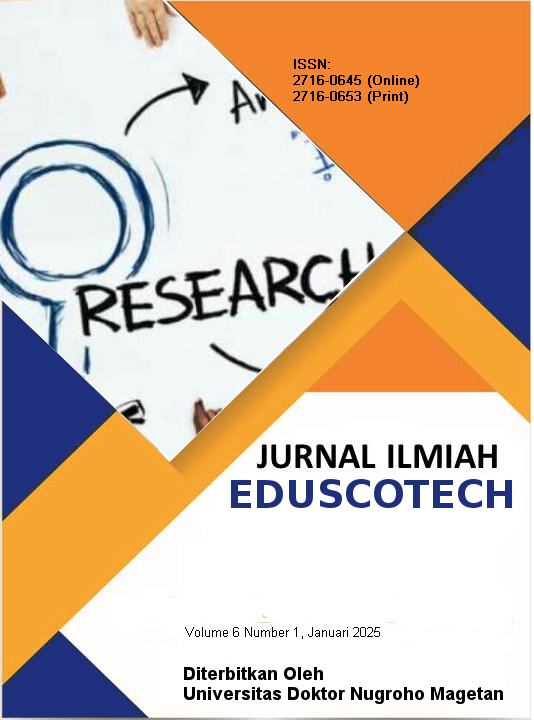Teknik Setting Out Pekerjaan Konstruksi Diatas Lahan Tanah Dengan Kemiringan 30% Pada Perancangan Bangunan Rumah Hunian
Keywords:
Setting Out Technique, Construction Work, Building Design, Residential Buildings, High-Rise BuildingsAbstract
This study aims to analyze the setting out technique for construction work on land with a 30% slope in the design of residential buildings. Steep terrain requires a special approach to determine the position and elevation of building structures to ensure stability and safety. The setting out technique is a crucial step in ensuring that building elements, such as foundations and structures, are constructed in accordance with the planned design. This research examines the methods and measuring tools used in setting out on sloped land, as well as the factors affecting measurement accuracy, such as topographic conditions and the use of appropriate equipment. In this study, modern measuring tools such as Total Station and GPS were employed to achieve high levels of accuracy in marking key points on sloped land. Additionally, attention is also given to precise elevation calculations, drainage planning, and determining the foundation placement to ensure building stability on sloped terrain. The results indicate that the use of accurate measurement technology and careful planning significantly influences the success of setting out on sloped land. Errors in the setting out process can lead to structural discrepancies, reduced building quality, and even foundation damage. Therefore, technical skills and a strong understanding of the challenges in sloped land construction are required from construction professionals.This research is expected to contribute to the development of setting out techniques in construction projects on sloped land, particularly in the design of residential buildings, thus enhancing the quality and safety of building structures on challenging topographical terrain.
Downloads
References
Hirai, H. (2022). Failure surface for shallow foundations in non-homogeneous sand under combined loading. Computers and Geotechnics, 145, Article 104908. DOI: 10.1016/j.compgeo.2022.104908 (ScienceDirect)
Bhardwaj, A., & Sharma, R. K. (2022). Bearing Capacity Evaluation of Shallow Foundations on Stabilized Layered Soil using ABAQUS. Studia Geotechnica et Mechanica, 45(1), 55–68. DOI: 10.2478/sgem-2022-0026 (ResearchGate)
Karaulov, A. M. (2022). Bearing Capacity Assessment of Soil Foundation Beds via Limit Equilibrium and Numerical Methods. Arabian Journal of Geosciences, 15, … DOI: 10.1007/s11204-022-09790-y (SpringerLink)
Chaabani, W., et al. (2023). Ultimate Bearing Capacity of Strip Footings on Sand with Voids over Clay using FLAC 2D. Materials, 8(1), Article 3. DOI: 10.3390/materials8010003 (ResearchGate)
Tripathi, S., Sisodia, S. S., et al. (2023). Influence of an Interbedded Weak Clay Layer on Ultimate Bearing Capacity of Sandy Soil Using AFELA and MARS. Geotechnical and Geological Engineering. DOI tersedia di artikel (ResearchGate)
Chen, G. (2023). Upper-bound solution of the horizontal bearing capacity of a composite bucket shallow foundation in sand. International Journal of Geomechanics. DOI: artikel tersedia (Taylor & Francis Online)
Panwar, V., & Dutta, R. K. (2024). Review on the effect of load inclination and eccentricity on bearing capacity of shallow foundations. Archives of Computational Methods in Engineering, 31, 4189–4208. DOI: 10.1007/s11831-024-10113-7 (SpringerLink)
Zhao, Z., et al. (2025). Probabilistic Analysis of Bearing Capacity for Sand Overlying Clay Using Monte Carlo Simulation. Engineering Geology. DOI: tersedia (ResearchGate)
Aksoy, H. S., & Kayaalp, D. K. (2025). Experimental investigation of lateral stresses and bearing capacity of sandy soil under shallow foundation loads. Applied Sciences, 15(12), 6699. DOI: 10.3390/app15126699 (ScienceDirect)
Khan, A. et al. (2022). The effect of groundwater level on the bearing capacity of a shallow foundation. Applied Sciences, 12(13), 6571. DOI: 10.3390/app12136571 (ResearchGate)
Reddy & Manjunatha (2022). Plate load test on compact sand under various groundwater levels. Ain Shams Engineering Journal. DOI: tersedia (MDPI)
Ghiasi, V. (2022). Optimization of the Bearing Capacity of Shallow Foundation. Reliability Engineering & Resilience. DOI: 10.22115/rer.2022.360789.1049 (rengrj.com)
Tripathi, S., et al. (2023). Comparative study of analytical, FEM, and machine learning approaches for predicting bearing capacity on sandy soils. Geotech Geotechnical Engineering. DOI tersedia (ResearchGate)
Karaulov, A. M., & kolega (2022). Limit Equilibrium vs FEM in Bearing Capacity Assessment. Arabian Journal of Geosciences. DOI: 10.1007/s11204-022-09790-y (SpringerLink)
Ascelibrary (2025). Discussion of “Effect of Footing Geometry and Embedment on the Bearing Capacity…”. Journal of Geotechnical & Geoenvironmental Engineering. DOI tersedia (ASCE Library)
SciOpen (2023). Bearing capacity of shallow foundations considering geological uncertainty and soil spatial variability. Journal of Rock and Soil Mechanics. DOI: 10.16285/j.rsm.2023.5540 (SciOpen)
Downloads
Published
Issue
Section
License

This work is licensed under a Creative Commons Attribution-ShareAlike 4.0 International License.
Authors who publish with this journal agree to the following terms:
1. Copyright on any article is retained by the author(s).
2. The author grants the journal, right of first publication with the work simultaneously licensed under a Creative Commons Attribution License that allows others to share the work with an acknowledgment of the work’s authorship and initial publication in this journal.
3. Authors are able to enter into separate, additional contractual arrangements for the non-exclusive distribution of the journal’s published version of the work (e.g., post it to an institutional repository or publish it in a book), with an acknowledgment of its initial publication in this journal.
4. Authors are permitted and encouraged to post their work online (e.g., in institutional repositories or on their website) prior to and during the submission process, as it can lead to productive exchanges, as well as earlier and greater citation of published work.
5. The article and any associated published material is distributed under the Creative Commons Attribution-ShareAlike 4.0 International License









